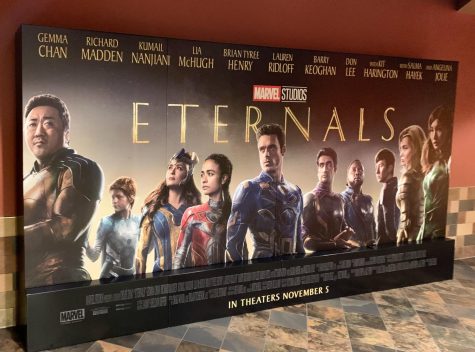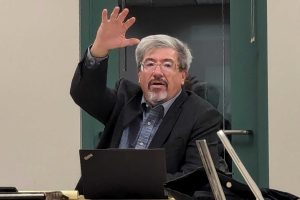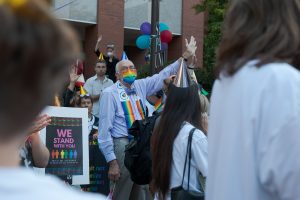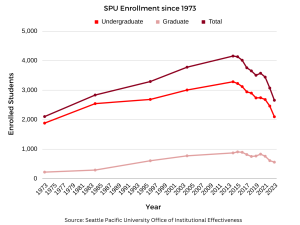Marvel makes history with inclusive cast
“Eternals” redefines the traditional superhero
November 12, 2021

Why do superheroes exist? For some, it sparks the hope in average humans that their lives can be extraordinary. To help them see themselves as purposeful, valuable and capable. However, not every person has been made to feel empowered due to the limited selection of heroes in the Marvel Cinematic Universe (MCU). That is, until now.
In the beginning, there were the Eternals. These immortal beings were created with the capacity to save human life and were instructed only to interfere in human conflict if Deviants, nearly indestructible monsters, were involved. Each of the 10 Eternals was given the purpose to protect Earth…or so they thought.
For seven thousand years, the Eternals worked together to fight against the Deviants, following orders from their creator, a mysterious cosmic being called Arishem. But after Druig (Barry Keoghan) decides their leader, Ajak (Salma Hayek), is not trustworthy, and they believe all the Deviants are dead, the team splits up.
It is not until five hundred years later that the reemergence of the Deviants forces the Eternals to band together once more under a new leader, Sersi (Gemma Chan), a member of the Eternals family.
“Eternals” is a landmark film containing one of the most diverse casts in the MCU. Not only are people of color predominant members of the team, but Makkari (Lauren Ridloff) is the first deaf character, and Phastos (Brian Tyree Henry) is the first openly gay person in the MCU. There is even a child hero portrayed, Sprite (Lia McHugh), which diminishes the stereotype that only adults can change the world.
Much of the movie “Eternals” revolves around Sersi recognizing her leadership capabilities and inner strength after spending most of her life being underestimated, particularly by her former lover and fellow superhero Ikaris (Richard Madden). She grew accustomed to living as a regular person and is faced with a heartbreaking choice: protect a self-destructing, yet beautiful world, or stay loyal to Arishem?
Each of the Eternals has a different view of humanity, yet they realize that the only way to conquer their greatest enemy is through unity. Nonetheless, this action does not require any of them to revoke their own identity. Rather, their differences are what make the team stronger. In today’s divisive culture, messages promoting understanding and reconciliation are imperative.
Though less prominent, there is encouragement for those struggling with mental illness as well. Thena (Angelina Jolie) develops a memory disease that causes her to experience intense moments of fear and separation from her loved ones. However, through the loving support of her family and the intentional care from Gilgamesh (Don Lee), a fellow Eternal, she is able to see her worth and even motivate others when they are struggling.
While crafting the heroes for “Eternals,” designers took the creative liberty of swapping the genders and racial identities of several of the characters from the original comics, which “Eternals” is based on. This allowed for Asian, Mexican and African representation. Their cultures were celebrated, such as Eternal superhero Kingo (Kumail Nanjiani) performing a Bollywood dance number as his grand debut.
By featuring a well-rounded cast, certain audience members can see themselves represented for perhaps the first time in their lives. While this is certainly a triumph, these firsts seem to have come at the cost of other important elements of the film.
Due to the large number of heroes, it can be difficult getting to know each character on a deeper level. There is a lack of internal conflict at the beginning, which makes viewers less likely to bond with the heroes right away. With so many subplots and characters, transitions between scenes can feel unnatural, while the plots themselves tend to be underdeveloped.
After years of uniformity in casting choices, it is no wonder the creators of “Eternals” exerted much of their effort in cultivating a varied group of actors. Historically, by sticking too close to the original (and perhaps outdated) comics, Marvel has missed many opportunities to present fresh, diverse superheroes. For example, nearly all of the original Avengers team members are white, and very few of them are female. “Eternals” is a leap in the right direction by reaching a broader audience in an attempt to enlarge their fanbase and meet the higher expectations of this generation.
Between the impeccable cinematography, outstanding computer-generated imagery and intense action scenes, viewers can hardly peel their eyes off the screen. The settings, whether mystical or metropolitan, cultivate an ambiance that inserts the audience directly into the story. The action sequences, though occasionally long-winded, flow together beautifully.
If watched critically, “Eternals” leaves viewers with an appreciation for finding the beauty within a broken world. Messages regarding unity, acceptance and love may spark positive changes in the lives of audience members. These lessons come at the cost of digging through an overwhelming influx of information. But in a media-obsessed world, perhaps today’s superhero fans are prepared for the challenge.
“Eternals” is rated PG-13 for sequences of fantasy violence and action, some language and brief sexuality.

























































































